We tested the Specialized Epic 8: the XC bike that everyone is talking about in 2024
The new Specialized Epic 8 arrived in 2024 as one of the most anticipated updates of recent years, and since we first saw it, we knew we were facing a paradigm shift. With this new version, Specialized has not just evolved, but reinvented its Epic. We took the time to thoroughly test the new Epic 8, and here we share all our impressions of a bike that will not leave anyone indifferent.
The new Epic 8 enters a new era with its definitive farewell to the Brain
That is the most striking feature of this new Epic 8 version. The Brain, since it first appeared in the first version of the Specialized Epic back in 2003, has been the hallmark of a unique bike, clearly differentiated from the rest thanks to a technology that was only found in the brand's bikes and allowed us to forget about lockout levers as the suspensions did everything for us.
There have been many evolutions of the Brain itself, some of which were criticized for reliability issues, but the truth is that the last version had very good performance.
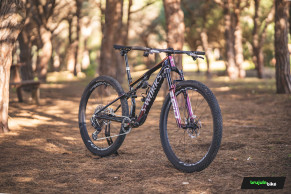
RECOMENDADO

Tips for cycling in the rain

25 cycling gifts ideas to get it right

When do helmets have to be changed? Do they have an expiration date?

Some reasons to stay away from the road in winter
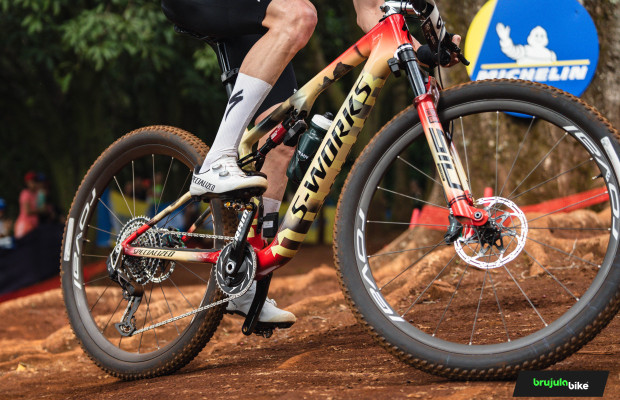
S-Works: what does it really mean and where does Specialized's most exclusive label come from?

The best apps for cycling and mountain biking
But technology evolves and Specialized has opened up other paths to continue improving and to have the fastest and most efficient bike possible.
Last year, the Epic World Cup was already presented, a double with less travel that replaces the rigid Epic HT, and it did so without the Brain but with a specific shock absorber that gives it a performance that follows the same philosophy, that the suspension only activates in response to terrain impacts and not to the rider's movements. This Epic WC still has no lockout lever.
Now in the new Epic 8, a shock absorber developed specifically for this bike is also used, with characteristics in its operation that complement the kinematics of the Epic 8. It has three operating positions but, specifically in the intermediate mode, is where Specialized has found a behavior that, leaving behind the Brain, achieves something very similar. A fairly firm pedaling platform that, once that initial resistance is overcome, offers the full travel of the shock absorber to absorb any impact that may occur. They call it Magic Middle and in our tests we have tried to verify similarities and differences with the old Brain.
As you can see, so far we have not made reference to the most striking technology that our test bike incorporates. The great novelty from Rock Shox, the Flight Attendant for XC / Marathon bikes, was presented at the same time as the new Epic 8.
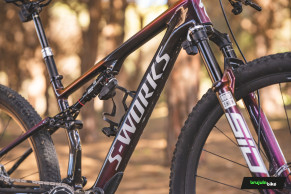
We had the opportunity to test it about two years ago, when it was focused on Trail and Enduro modalities, and it left us with a very good impression. But it was evident that this technology was destined to establish itself definitively in Cross Country bikes.
The Flight Attendant, in the Specialized Epic 8, is only found in the S-Works version, but we can already anticipate that, although it is something so striking and attention-grabbing, the new Epic 8 does not revolve around the Flight Attendant, but rather it is an ideal complement that culminates a bike that by itself already presents serious credentials to once again be a reference.
The Epic adapts to modern times
In the design of the Epic 8 frame, we see how, remaining faithful to the goal of designing the most efficient bike possible, they have not overlooked current solutions, such as cable routing through the head tube or the storage space in the down tube, which is becoming increasingly common.
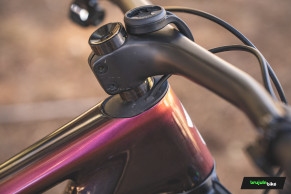
Observing the frame, which in the case of the S-Works is made of FACT 12m carbon, we can see a clear increase in the size of the down tube, which starts from a slightly more voluminous head tube, and a few centimeters later acquires a constant width up to the lower curve. In this tube, at the height of the bottle cage, we find the so-called SWAT 4.0, which is that compartment inside it. It is accessed through a window with a very clear opening system, with a generous lever, and is well sealed thanks to a rubberized contour.
Inside, we can see the complete routing of the brake hose.
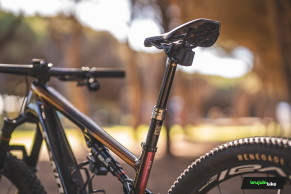
As stated in the specifications, the S-Works frame is optimized for wireless transmission and seatpost, so we do not find any other guides, so in case of mounting a mechanical dropper post, the cable would be loose.
In the rest of the frame, we do not find very relevant differences compared to the previous version, except for one obvious change, which is the absence of the space that the Brain occupied in the chainstay or the hardware for its routing.
We were impressed by the exquisite work done on the shock extender, made of carbon and with a truly refined appearance. In the attachment of the shock to this extender, there is a flipchip that can be reversed to modify the geometry, giving the Epic the possibility to change its head angle by 0.5° and vary the bottom bracket height by 5mm, among other things.
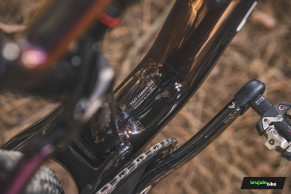
In the rest of the frame, we find design details where efforts to shave off every possible gram are evident. We were struck by the shock attachment to the frame. Instead of being manufactured using compression molds, it is a hollow structure integrated into the shape of the top tube.
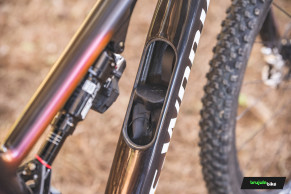
In the head tube area, we have the hose entry through the top cap, similar to what we saw in the Epic World Cup. It is a clean and discreet entry, compatible with any stem and handlebar. It only allows the entry of two hoses and this system is only found in the S-Works version. In the rest of the range, the entry is at the front of the frame and allows up to four entries for different mounting options.
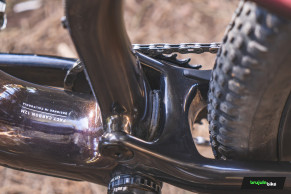
The frame comes with the usual protections on the chainstay and seatstay, to protect and silence the impacts of the chain, and also includes a generous rubber protector on the lower part of the down tube.
Specialized announces a weight reduction of 76 grams compared to the predecessor S-Works, which, considering the increase in travel and capacity, is quite an achievement.
Geometry for the most current XC
In recent years, geometries have evolved rapidly, and today we find lengths and head tube angles on XC bikes that a few years ago would have been considered radical even on Trail bikes. This trend has not stopped, and we see it as a positive development, as it greatly improves capability on challenging terrain and safety at high speeds without penalizing handling and agility.
In the new Specialized Epic 8, of course, there is no exception, and it goes even further in this direction. In fact, the geometry of this new Epic inherits much of what we found in the previous Epic EVO, the bike theoretically more focused on the so-called Down Country, which was chosen last season by Specialized riders on many World Cup circuits.
The new Epic EVO, on the other hand, has gone a step further in its Down Country capabilities, but we will focus on the features of our Epic 8.
In the Epic, we find a head tube angle of 66.4° if we choose the high position on the shock chip. In the low position, it goes to 65.9°, a really radical head tube angle on an XC bike.
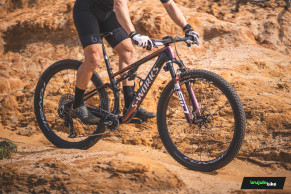
The reach increases slightly to 450mm in size M. The seat tube angle is 75.5°, which is quite steep to enhance climbing but not exaggerated.
The bottom bracket height varies slightly depending on the size. In size M, we have 326mm in the low configuration or 331mm if we opt for the high position.
The chainstays are 335mm constant in each size, and the wheelbase is quite long, reaching 1179mm in size M.

With these measurements, the intentions of the Epic 8 to become one of the best descenders among Cross Country bikes are clear, although those who are not convinced by the extremes have a slightly more moderate configuration, but equally capable, in the high position of the chip.
S-Works Epic 8: luxury build with a clear goal
Our test bike has an overwhelming level of detail in its build, but we are talking about one of the most expensive bikes on the market, and nothing has been left out.
The suspensions, as you already know, include the latest innovation from Rock Shox in its most exclusive version.
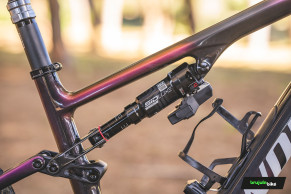
The Rock Shox SID Ultimate Flight Attendant, newly released, comes with a specific tuning for this Epic 8 and with its three electronically controlled positions, it offers 120mm of travel.
It is worth noting that the previous version of the Epic had SID SL with 32mm stanchions, now in addition to more travel, there is a slightly sturdier fork with 35mm stanchions.
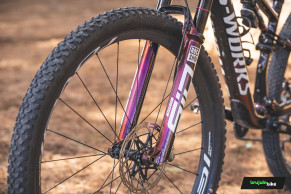
The shock absorber, logically, is the partner of this SID, it is the Rock Shox SIDLuxe Ultimate Flight Attendant, also with its three wirelessly controlled positions by the brain of the system.
The Flight Attendant ecosystem is completed with the power meter included in the Sram XX SL cranks and the left Sram AXS Pod Ultimate shifter, which, in addition to actuating the seatpost, has another button that activates some Flight Attendant functions that we will tell you about.
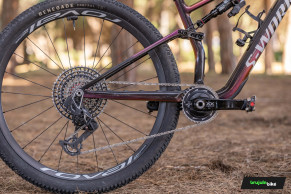
The transmission is Sram's top-of-the-line, the XX SL Eagle AXS version, with a 34-tooth chainring in its configuration.
Also, in the brakes, we have the exclusive Sram Level Ultimate 4-piston brakes, with 180mm discs in the front and 160mm in the rear.
The wheels are Roval Control SL, with their asymmetric carbon rims with a 29mm internal width and their hubs with the DT 180 mechanism with ceramic bearings.
The tires mounted are the Fast Trak in the front and the Renegade in the rear, both in a 2.35" width. We are struck by the front tire with Control casing instead of the S-Works that the previous S-Works Epics had, another example of this Epic 8's trend to opt for more robust components at the expense of sacrificing some grams.
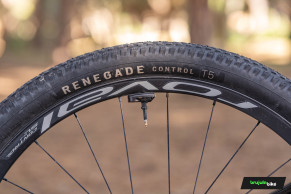
The wheels mount Quarq TyreWiz pressure sensors that are part of the entire AXS component set, so in the AXS app, we can monitor the pressure and set a range so that if the pressure drops, it will alert us through the LED included in each sensor or directly display the values on our GPS screen.
In the components, we continue with the most exclusive from the brand with the integrated Roval Control SL cockpit, which was introduced last year and gives the Epic a spectacular aesthetic. The virtual stem length is 60mm in all sizes.
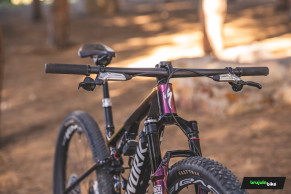
The seatpost completes the AXS ecosystem with the Rock Shox Reverb wireless with 125mm of travel on our test bike. In size L, it offers 150mm and 170mm in size XL.
On this, the S-Works Power saddle with carbon shell and rails is mounted.
The bike includes the SWAT bag inside the frame for storing the necessary spare parts and also a small multitool attached to the bottle cage. In addition, on the cover that closes the frame opening, there are attachments to hold a pump or CO2 bottle.
Live impressions with the 2025 Epic 8
Few bikes create as much anticipation as the launch of a bike like the Epic, so we were eager to see it in person. As soon as we took it out of the box, we admired the level of detail with which it is built.
The paint is very striking, with that blurring and that chameleon-like paint that slightly changes the tone depending on the angle from which you look at it. The fork is also decorated in the same way.
But above all, the Flight Attendant seems to attract the attention of the observer with its flashing LEDs. Particularly in the interior, its illumination is particularly striking and is immediately activated by lightly touching the bike.
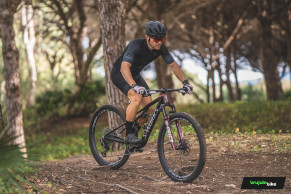
The Specialized Epic 8 S-Works is undoubtedly one of the bikes with more integrated technology that has passed through our hands, and that is something that involves certain aspects that some users may not convince, such as the fact of adding, between rechargeable batteries and batteries, up to nine units.
On the one hand we have four Sram AXS batteries: in the rear derailleur, the telescopic seatpost, the fork and the shock.
Although the duration varies slightly depending on the component on which it is mounted, it is clear that every few rides we will have to be aware of what needs to be charged.
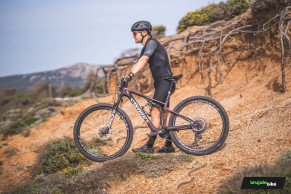
And apart from the rechargeable batteries we have another 5 batteries distributed in each Pod AXS pushbutton, the potentiometer and in both Quarq TyreWiz pressure sensors.
It seems that the future leads us down this path and we will have to take this task of checking batteries as a matter of course if we want to enjoy the latest systems.
We complied with the scale protocol and weighed it before putting the pedals on. We marked 10.48kg. Really good figure if we take into account the details of its assembly that are not at all exposure components but is prepared for everything as it comes out of the box.
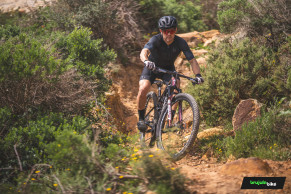
In the first kilometers with the Epic 8 S-Works we could not help but be aware of what the Flight Attendant does. We had already tried it before and it took us a few hours of adaptation to trust and stop being aware of its operation. There is much to tell about the operation of the Flight Attendant, and we will talk about it in much more detail in a test that we will publish separately. In this test we will focus mainly on the bike itself.
In order to differentiate the Epic's behavior in each suspension position, we ran the Flight Attendant in manual mode for a couple of rides. May Rock Shox engineers forgive us for what for them must be sacrilege, but we needed to feel the Epic 8's behavior without interference.
After the first checks of each mode, we set the suspensions in the intermediate mode, customized by Specialized and christened Magic Middle. This is one of the most interesting new features of the new Epic 8. The compression curve of the shock has been modified with respect to the standard middle mode, and now requires slightly more force to start compressing. Once active, it shows a linear and absorbing behavior.
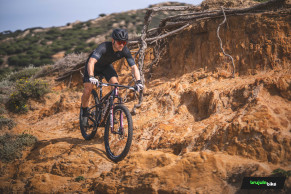
Saving the distances, it is a behavior that reminds us of the previous version with the Brain open one or two points. But there is no Brain, so we will not feel the characteristic activation impact nor will we feel the rear as firm as with a closed Brain.
To evaluate this new Magic Middle, we rode it stationary for quite a few kilometers. When pedaling seated we did not notice any oscillation of the suspension due to our movements, only when pedaling hard standing up we felt some slight movement at any rate. The Epic in this mode does not have a total sensitivity to small irregularities, but when there are medium impacts the suspension is activated and the 120mm of travel is used quite well because the rate is quite linear once this kind of initial threshold is overcome.
According to Specialized this mode of the shock absorber is ideal for 80% of the situations and our opinion is that it is quite true. Compared to the previous Brain we still don't have the sensitivity and comfort of a fully open system, and on the other hand we don't have the firmness of a full lockout or a fully closed Brain, so, although it is a setting that covers a wide range of situations, it is logical that the Specialized Epic now has 3 positions.
Unfortunately, models without Flight Attendant become a bit more “earthy” and have to go back to cables and remote control, but in the case of our S-Works test version we benefited from the technology to still have a cable-free bike and suspension that manages itself.
Increased travel distance does not reduce efficiency
You might think that by following the trend of increased travel and Down Country geometry, the new Epic 8 would not be as effective when it comes to pedaling and translating every watt of our legs into speed. But the truth is that the new Epic still feels like a race bike, where it's very easy to accelerate and maintain high cruising speeds while making the most of our effort.
When we stand up the bike reacts immediately, helped by the Flight Attendant management that, whenever the terrain allows it, locks the suspension, giving the Epic S-Works a very high reactivity. In these situations the lightness of a bike that, although it has increased its capabilities, is still one of the lightest options on the market.
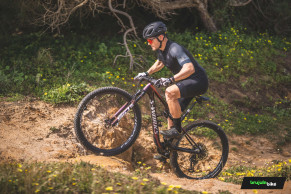
In these full throttle situations we missed a slightly more attacking position. The Roval Control SL integrated cockpit comes with a virtual stem length of 60mm in all sizes and, in addition, our test unit came with several steering spacers and at least one we had to leave under the stem so as not to interfere with the GPS. Thus the position is very comfortable for getting off and maintaining control, but we would have liked a slightly more racing stance on a bike like this.
The Epic 8 shows its virtues when the terrain becomes more difficult
It was clear that the changes that the Epic has undergone in terms of geometry and suspension travel were going to improve its behavior and we only needed a couple of forays on technical trails to prove it.
The Epic 8 is docile and stable when it comes to cornering at certain speeds, and when the terrain becomes rougher and wilder it shows a very high capacity thanks to the absorption of its suspension and a feeling of firmness in the line resulting from a perfect balance in the overall rigidity of the bike.
It is increasingly common in the latest releases of modern XCO bikes that we dare to take them to the most enduro trails of our usual testing area, and the Epic 8, not only has not been an exception, but it has made us enjoy the most complicated trails as if it were a Trail.

The limits of a bike like the Epic 8 are far enough away. It is striking how the efficiency and speed of a bike designed for racing coexists with that sufficiency and capacity in the most technical terrain that makes the fun appear in all those sections where our ability is tested.
Conclusions
After a season of intense use we can say that we have become accustomed to the good things the Epic 8 S-Works has to offer. The fact of riding with a really chameleon-like bike where we don't even have to be aware of the terrain ahead of us, as it adapts itself to whatever comes our way and makes any situation easier for us, means that we can really be faster.
Living with electronics requires paying that small “toll” of taking into account battery levels and so on, but the behavior of a bike like the Epic S-Works more than makes up for it.
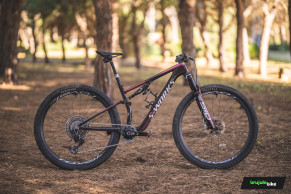
In the new Specialized Epic range we have, in addition to this exclusive S-Works model, three other models.
The Epic Pro, mounted with Sram XO AXS Eagle Transmission, SID and SIDLuxe Ultimate suspensions and Roval Control Carbon wheels, is priced at €9,500.
The Epic Expert model mounts Sram GX AXS Eagle Transmission, Rock Shox SID Select+ suspension and Roval Control Carbon wheels at a price of 7,500€.
And the entry-level model is the Epic Comp, which for 5,200€ offers Sram GX mechanical drivetrain, Rock Shox SID Select suspension and Specialized aluminum wheels.
The S-Works frame and fork kit is also available for €6,500.
Specialized S-Works Epic 8: specifications, weight and price
- Frame: S-Works Fact 12m, 120mm
- Fork: RockShox SID Ultimate Flight Attendant, Ride Dynamics, 120mm
- Shock: RockShox SIDLuxe Ultimate Flight Attendant, Ride Dynamics
- Saddle: Body Geometry S-Works Power
- Handlebar: Roval Control SL integrated cockpit, 60mm, 760mm wide
- Brakes: Sram Level Ultimate Stealth, 4-piston
- Rear derailleur: Sram XX SL Eagle AXS
- Shifter: Sram AXS Pod Ultimate
- Cassette: Sram XX Eagle SL 10-52t
- Chain: Sram XX SL Eagle
- Crankset: Sram XX SL Eagle Power Meter, 34t
- Wheels: Roval Control SL Carbon
- Front tire: Specialized Fast Trak Control T7, 2,35”
- Rear tire: Specialized Renegade Control T5, 2,35”
- Seatpost: RockShox Reverb AXS
- Weight: 10.48kg
- Price: 14,500€